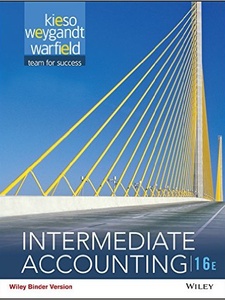Which of the following is an example of a profit center Quizlet ✅ Chất
Thủ Thuật về Which of the following is an example of a profit center Quizlet 2022
Dương Anh Sơn đang tìm kiếm từ khóa Which of the following is an example of a profit center Quizlet được Cập Nhật vào lúc : 2022-08-27 19:25:08 . Với phương châm chia sẻ Bí kíp Hướng dẫn trong nội dung bài viết một cách Chi Tiết Mới Nhất. Nếu sau khi Read Post vẫn ko hiểu thì hoàn toàn có thể lại Comments ở cuối bài để Ad lý giải và hướng dẫn lại nha.Nội dung chính
- Which of the following is an example of a profit center?What is a profit center quizlet?What is profit center in cost accounting?What is a cost center quizlet?
 Glencoe Accounting: First Year Course
Glencoe Accounting: First Year Course1st EditionGlencoe McGraw-Hill
548 solutions
 Financial Accounting
Financial Accounting2nd EditionDon Herrmann, J. David Spiceland, Wayne Thomas
1,208 solutions
 Financial Accounting
Financial Accounting4th EditionDon Herrmann, J. David Spiceland, Wayne Thomas
1,097 solutions
 Intermediate Accounting
Intermediate Accounting16th EditionDonald E. Kieso, Jerry J. Weygandt, Terry D. Warfield
2,304 solutions
The after-tax operating income reported by Beta, Inc., is $125,000. The weighted average cost of capital is 15.30 percent, and the total capital employed is $750,000. Determine the economic value added (EVA) of Beta, Inc.
a.$100,000
b.$10,250
c.$114,750
d.$15,000
 Financial Accounting
Financial Accounting10th EditionCharles T. Horngren, C William Thomas, Walter T. Harrison Jr.
928 solutions
. Responsibility accounting is defined as a system that
a.
defines responsibility by function only.
b.
measures actual results against a flexible budget.
c.
measures the results of a manager responsible for revenues and costs.
d.
measures the results of each responsibility center and compares those results with some measure of expected or budgeted outcome.
d
A manufacturing division of a company would most likely be evaluated as a(n)
a.
cost center.
b.
investment center.
c.
revenue center.
d.
asset center.
a
Which of the following departments is likely to be an investment center?
a.
machining department
b.
food products division
c.
personnel department
d.
accounting department
b
. Both revenue center and profit center managers are responsible for achieving
a.
budgeted revenues.
b.
budgeted net income.
c.
budgeted costs.
d.
budgeted contribution margin.
a
Which of the following departments in an organization is a profit center?
a.
The Marketing Department
b.
The
Administration Department
c.
The Automotive Department
d.
The Accounting Department
c
Which of the following responsibility centers would have a manager responsible for revenues, costs, and investments?
a.
cost center
b.
investment center
c.
profit center
d.
expense center
b
. A manager of a profit center does not control:
a.
Revenues
b.
Costs
c.
Profits
d.
Investments
d
The manager of a profit center is responsible for
a.
delivering a quality product or service reasonable but minimal cost.
b.
decisions to invest in capital equipment.
c.
decisions regarding revenue generation.
d.
both a and c.
d
The manager of an investment center is responsible for
a.
decisions regarding costs.
b.
decisions regarding revenues.
c.
decisions to invest in assets.
d.
all of these.
d
Which of the following departments would NOT be a cost center?
a.
advertising department
b.
city police department
c.
building
and grounds department
d.
sales department
d
An example of an investment center is a
a.
production department.
b.
company.
c.
marketing department.
d.
credit department.
b
The Marketing Department of a factory is an example of a _____.
a.
profit center
b.
revenue
center
c.
cost center
d.
investment center
b
The delegation of decision-making authority to successively lower management levels in an organization is called:
a.
Centralization
b.
Decentralization
c.
Optimization
d.
An unfavorable overhead variance
b
When top management controls the major functions of an organization it is called:
a.
Centralization
b.
Decentralization
c.
Optimization
d.
An unfavorable overhead variance
a
Which of the following would NOT be a reason for decentralization?
a.
Managers will make decisions for their own benefit, rather than the organization's benefit.
b.
Lower level managers have better access to
information.
c.
Upper management can spend more time focusing on strategic planning and decision making.
d.
Lower level managers with decision-making ability are more motivated.
a
One of the reasons for decentralization is more timely response. This means
a.
lower-level managers being more in contact with immediate operating conditions.
b.
central management can be không lấy phí to
focus on strategic planning.
c.
allowing an organization to determine each division's contribution to profit and expose each division to market forces.
d.
local management both makes and implements decisions.
d
Which of the following changes would NOT change return on investment (ROI)?
a.
Decrease sales and expenses by the same percentage.
b.
Increase total assets.
c.
Increase
sales dollars by the same amount as total assets.
d.
Decrease sales and expenses by the same dollar amount.
d
Which of the following changes would increase return on investment (ROI)?
a.
Decrease sales and expenses by the same percentage.
b.
Increase total assets.
c.
Increase sales and expenses by the same percentage.
d.
Decrease sales and expenses by the same dollar
amount.
c
Which of the following is a disadvantage of both residual income and ROI?
a.
They are both absolute measures of return.
b.
They are both difficult to calculate.
c.
They both do not discourage myopic behavior.
d.
All of these are disadvantages of both ROI and residual income.
c
Which of the following is true of economic value added (EVA)?
a.
It emphasizes after-tax operating income and actual cost of capital.
b.
It includes all assets used to generate operating income.
c.
It is the difference between operating income and operating assets.
d.
It typically uses a minimum expected rate of return.
a
The transfer price that would leave the selling division no worse off if the good is sold to an internal division is(are) called:
a.
The maximum transfer price
b.
The negotiated transfer price
c.
The minimum transfer price
d.
Both a and c
c
. The transfer price that would leave the buying division no worse off if an input is purchased from an internal division is(are) called:
a.
The maximum transfer price
b.
The minimum
transfer price
c.
The negotiated transfer price
d.
Both a and c
a
Which of the following is an example of a profit center?
All of the following are examples of profit centers: Individual restaurants in a large restaurant chain. Manufacturing divisions in a large corporations. Individual retail stores in a large retail chain.What is a profit center quizlet?
A profit center is a subunit of a company that is responsible for revenues and costs. Often a division of a company is a profit center because it has control over its revenues, costs, and the resulting profits.What is profit center in cost accounting?
A profit center is a branch or division of a company that directly adds or is expected to add to the entire organization's bottom line. It is treated as a separate, standalone business, responsible for generating its revenues and earnings.What is a cost center quizlet?
A cost center is a responsibility center that incurs costs (or expenses) but does not directly generate revenue. Tải thêm tài liệu liên quan đến nội dung bài viết Which of the following is an example of a profit center Quizlet